
- Home
- Artist
- Andy Warhol (98)
- Banksy (341)
- Charley Harper (15)
- Cocomilla (27)
- Damien Hirst (84)
- Dface (22)
- Invader (30)
- Kaws (52)
- Keith Haring (30)
- Laurent Durieux (24)
- Martin Whatson (30)
- Modern & Luxury (22)
- Pablo Picasso (63)
- Roy Lichtenstein (19)
- Shepard Fairey (92)
- Space Invader (22)
- Takashi Murakami (48)
- Thomas Kinkade (25)
- Tyler Stout (16)
- Unknown (146)
- Other (3748)
- Brand
- Arttor (5)
- Canvas (47)
- Canvas Geeks (11)
- Canvasunique (7)
- Coach (28)
- Coloray (21)
- Cox & Cox (3)
- Gucci (3)
- Himitsuhana (3)
- Ink North (10)
- Marc Jacobs (9)
- Michael Kors (2)
- Modern & Luxury (9)
- My Swanky Home (3)
- Photos On Canvas (2)
- Picutre Prints (2)
- Pop Art (7)
- Red Bus Prints® (18)
- Tb Creations (3)
- Tulup (52)
- Other (4709)
- Item Length
- Item Width
- Material
- Acrylglass (14)
- Acrylic (10)
- Canvas (322)
- Canvas Giclee Print (62)
- Canvas, Paper (17)
- Color Plate (16)
- Etching (8)
- Giclee & Iris (15)
- Glass (51)
- Gloss Paper (73)
- Leather (14)
- Lithograph (29)
- Matte Paper (21)
- Offset Lithograph (46)
- Paper (235)
- Paper Or Canvas (17)
- Papier (39)
- Pine (10)
- Print (30)
- Saffiano Leather (8)
- Other (3917)
- Size
- 152x102cm (60x40in) (15)
- 24 X 16 Inch (157)
- 36 X 24 Inch (12)
- 36x54 Inch Canf (9)
- 48 X 72 Inch Canf (20)
- 50cm X 70cm (51)
- 50x70cm (9)
- 54\ (10)
- 70x50cm (9)
- Extra Large (31)
- Large (122)
- Large (up To 60in.) (115)
- Massive 40\ (15)
- Medium (137)
- Medium (up To 36in.) (670)
- Small (36)
- Small (up To 12in.) (89)
- Small, Medium, Large (8)
- Various (60)
- Various Sizes (19)
- Other (3360)
JOSEF ALBERS Signed 1971 Color Line-cut Embossing White Embossing on Gray VIII
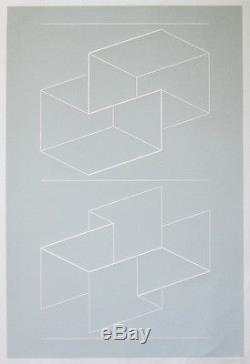

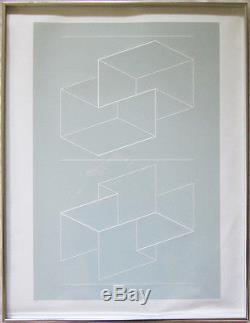


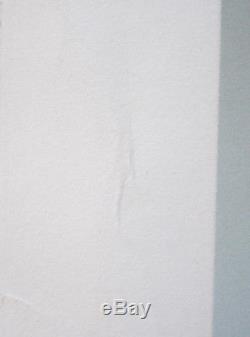
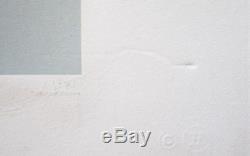
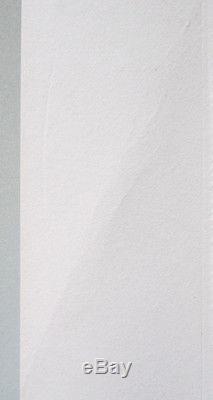
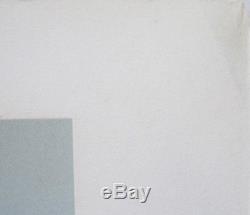


JOSEF ALBERS Signed 1971 Color Line-cut Embossing "White Embossing on Gray VIII". This rare original color line-cut embossing is entitled " White Embossing on Gray VIII". And is initialed in pencil by the artist on the front lower right and dated "71". It is also titled in pencil on the front lower left "WEG VIII" and numbered "100/125", from the total limited edition of only 125 impressions printed on Roleaf paper.
Developed this paper specifically for this printing project, as they required a unique surface that would capture the sharpness of the embossing while seamlessly accepting the gray ink. It measures 15 ½" x 23" (image) and is framed with glass in a silver metal section frame for a total size of 20 ¼" x 26 ¼". It was published by Gemini G. Los Angeles, with their embossed blindstamp on the lower right. There are condition issues to the paper, primarily in the lower left and right margins.
If matted, many of these would be covered. CATALOGUE REFERENCE: Gemini GEL NGA Catalogue Raisonne no. A prolific 20th-century artist, known primarily for his "Homage to the Square, " Josef Albers was also a highly innovative teacher associated with the Bauhaus in Weimar, Germany, Black Mountain College in North Carolina and the Yale School of Fine Art. Although he disavowed style category labels, he is credited with influencing the movements of Geometric Abstraction and Minimalism. He was also one of the first modern artists to investigate the psychological effect of art on viewers, to challenge them to open their eyes, investigate color and space, and to question the nature of perception.
Indicative of the impact of his work is the fact that he was the first living artist to have a solo exhibition at the Metropolitan Museum in New York. He was born to a family of craftsmen in Bottrop in the Ruhr region of Germany and inherited a family tradition of careful, exact workmanship.
As a young man, he became inspired by the works of Paul Cezanne, Henri Matisse, and other modernist artists, and many of his paintings show the influence of Cubism. In 1915, he married Anni Fleischmann, who became a noted weaver and his wife of fifty-one years. From 1913 to 1920, he studied art in Berlin and in Munich, but his most significant education took place in Weimar, Germany at the Bauhaus, an association of artists, craftsmen, and architects committed to a creed of merging craft techniques with creative aspects of fine art. As a student, he became renowned for stained glass designs that he created from broken bottles and fragments he found at the city dump. These "found object" designs show his early predilection for optics.
Beginning in 1923, he became a Bauhaus teacher and taught furniture design, drawing, and calligraphy. He made the first bent laminated wood chair and created some of the first stacking tables. His working philosophy was to build carefully and meticulously with sturdy materials from a base of simple, fundamental forms to increasingly complex shapes. In 1933, Albers and his associates dissolved the Bauhaus because of Nazi pressure against their creativity. He and his wife moved to America, where he spent the next sixteen years in North Carolina teaching at Black Mountain College, an experimental school operating with the principle that fine art integrated all learning.
In spite of the fact that he spoke no English at first, he influenced many artists who later became well known modernists such as Neil Welliver and Robert Rauschenberg. From 1950 to 1958, Albers served as Chairman of the Department of Design at Yale University where he produced hundreds of "homage to the square". The item "JOSEF ALBERS Signed 1971 Color Line-cut Embossing White Embossing on Gray VIII" is in sale since Thursday, May 04, 2017. This item is in the category "Art\Art Prints". The seller is "sf-fineart" and is located in Los Angeles, California. This item can be shipped worldwide.
- Main Color: Gray
- Subject: Abstract
- Edition Size: 125
- Date of Creation: 1971
- Style: Minimalism
- Print Type: Line-cut
- Edition Type: Limited Edition
- Artist: Josef Albers
- Size: Medium (up to 36in.)
- Print Surface: Paper
- Signed: Signed
- Framed/Unframed: Framed
- Original/Reproduction: Original Print

